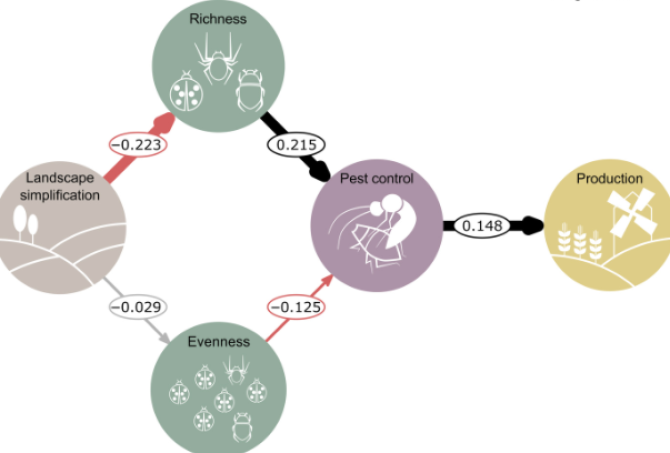
Thesis subject
Does nature help to enhance crop production?
The Environmental Systems Analysis Group provides the possibility for students to do their thesis in collaboration with our group. This is one of many possible thesis subjects. Please feel free to contact professor Alkemade (right) for more information.
A global analysis on nature’s contribution to biological pest control or pollination
Proposal for master theses or for internships at PBL Netherlands Environmental Assessment Agency
Level: Master/Internship
Students require: Statistical skills, and/or other strong quantitative methodological skills, e.g. GIS.
Start: Flexible; to be agreed upon with supervisors
Project form: Literature review and statistical modelling
Potential supervisors: Rob Alkemade, Susana Lopez Rodriguez, Lenny van Bussel.
Supervisors for internships at PBL: Rob Alkemade, Alexandra Marques, Aafke Schipper
Background
The GLOBIO model developed by PBL, in collaboration with partner organizations, is designed to assess impacts of environmental drivers, such as climate change and land use change, on biodiversity and ecosystem services globally. It has modules for terrestrial and aquatic biodiversity and for a large number of ecosystem services, including natural pest control and pollination by wild species.
Until recently, it was generally accepted that the presence of natural habitat near agricultural areas is beneficial to agriculture, for example by providing pollination and natural pest control services (Chaplin‐Kramer et al., 2011; Dainese et al., 2019). As a result, increasing natural habitat near agricultural areas was regarded as an effective strategy for both biodiversity conservation and sustainably increasing agricultural production. This has been incorporated in both the pollination and pest control modules of the GLOBIO-ES model. However, recent comprehensive global meta-analysis show inconsistent responses of pest control and pollination services to the presence of natural areas (Albrecht et al., 2020; Bennett et al., 2020; Karp et al., 2018; Perez-Alvarez et al., 2019; Tamburini et al., 2020). A good understanding of natural pest control and underlying drivers is essential to adequately assess and evaluate ecosystem services and for policy recommendation purposes.
Aim
In the internship/master thesis, you will contribute to a global model for the potential contribution of nature to biological pest control or pollination, as part of the GLOBIO model suite. You will assemble data from existing meta-analyses, collect additional literature data if needed, and perform statistical analysis in order to assess the effects of 1) natural areas in the vicinity of agricultural fields on natural pest control or pollination, 2) biodiversity within agricultural fields on natural pest control or pollination.
Approach and outcome
You will start by familiarizing yourself with the existing databases on pest control or pollination, which have been compiled in previous PBL projects and previously published meta-analysis. You will re-analyze the data with statistical models relating pest control or pollination variables to a selection of variables describing the agricultural fields and surrounding area (e.g., amount of nature, distance to nature, landscape complexity, biodiversity, crop diversity, management). Your analysis will result in quantitative models describing the relationship between biological pest control or pollination and various characteristics of the croplands and surrounding landscape (e.g., Fig. 1).

Literature
Albrecht, M., Kleijn, D., Williams, N.M., Tschumi, M., Blaauw, B.R., et al., 2020. The effectiveness of flower strips and hedgerows on pest control, pollination services and crop yield: a quantitative synthesis. Ecology Letters 23, 1488–1498. https://doi.org/10.1111/ele.13576
Bennett, J.M., Steets, J.A., Burns, J.H., Burkle, L.A., Vamosi, J.C., et al., 2020. Land use and pollinator dependency drives global patterns of pollen limitation in the Anthropocene. Nature Communications 11, 3999. https://doi.org/10.1038/s41467-020-17751-y
Chaplin‐Kramer, R., O’Rourke, M.E., Blitzer, E.J., Kremen, C., 2011. A meta-analysis of crop pest and natural enemy response to landscape complexity. Ecology Letters 14, 922–932. https://doi.org/10.1111/j.1461-0248.2011.01642.x
Dainese, M., Martin, E.A., Aizen, M.A., Albrecht, M., Bartomeus, I., et al. 2019. A global synthesis reveals biodiversity-mediated benefits for crop production. Science Advances 5, eaax0121. https://doi.org/10.1126/sciadv.aax0121
Karp, D.S., Chaplin-Kramer, R., Meehan, T.D., Martin, E.A., DeClerck, F., et. al, 2018. Crop pests and predators exhibit inconsistent responses to surrounding landscape composition. PNAS 115, E7863–E7870. https://doi.org/10.1073/pnas.1800042115
Perez-Alvarez, R., Nault, B.A., Poveda, K., 2019. Effectiveness of augmentative biological control depends on landscape context. Scientific Reports 9, 8664. https://doi.org/10.1038/s41598-019-45041-1
Tamburini, G., Bommarco, R., Wanger, T.C., Kremen, C., Heijden, M.G.A. van der, Liebman, M., Hallin, S., 2020. Agricultural diversification promotes multiple ecosystem services without compromising yield. Science Advances 6, eaba1715. https://doi.org/10.1126/sciadv.aba1715